Un nuevo estudio muestra un segundo caso de remisión exitosa del VIH después de un trasplante de médula ósea
Al menos un millón de personas mueren cada año por causas relacionadas con el VIH y casi 35 millones viven con VIH. El VIH-1 (virus de inmunodeficiencia humana) es responsable de la mayoría de las infecciones por VIH en todo el mundo y se transmite a través del contacto directo con fluidos corporales infectados por el VIH. El virus ataca y mata a las células cruciales de nuestro sistema inmunológico que luchan contra las infecciones. No existe cura para el VIH. Actualmente, el VIH solo se puede tratar con medicamentos que tienen la capacidad de suprimir el VIH. virus. These drugs have to be taken life long and it is challenging plus a cost burden on the health system especially in low-and-middle-income countries. Only 59 percent of patients of HIV worldwide are receiving Antiretroviral therapy (ARV) and VIH virus is fast becoming resistant from many known drugs which itself is a major concern.
Transplante de médula osea (BMT) is a treatment used for leukemia, myeloma, lymphoma etc. Bone marrow, the soft tissue inside bones, makes blood-forming cells including the infection fighting white blood cells. A bone marrow transplant replaces unhealthy marrow with a healthy one. In the first case of successful VIH remission, an VIH-infected individual called ‘Berlin Patient’ who later revealed his name received a bone marrow transplant a decade ago when he was targeted to treat acute leukemia. He received two transplants along with total body irradiation which led to long-term VIH remisión.
En un nuevo estudio publicado en Naturaleza led by UCL and Imperial College London, the only second person has been shown to experience sustained remission from HIV-1 after a bone marrow transplant and stoppage of treatment. The anonymous adult male patient from UK was diagnosed with HIV infection in 2003 and was on antiretroviral therapy treatment since 2012. He was subsequently diagnosed with Hodgkin’s Lymphoma in the same year and he underwent chemotherapy. In 2016, he was given stem cell transplant from a donor who carried a genetic mutation which prevents expression of a most commonly used VIH receptor protein called CCR5. Such a donor is resistant to HIV-1 strain of the virus which specifically uses CCR5 receptor and thus the virus now cannot enter host cells. Since chemotherapy kills cells which are dividing, VIH could be targeted. From this understanding if one’s immune cells are replaced by cells which do not have CCR5 receptor, VIH can be prevented from rebounding after the treatment.
El trasplante se realizó con efectos secundarios menores como una complicación leve común en los trasplantes en los que las células inmunes del receptor son atacadas por las células inmunes del donante. El tratamiento antirretroviral se continuó durante 16 meses después del trasplante antes de tomar la decisión de suspender el tratamiento para evaluar la remisión del VIH-1. Después de esto, la carga viral del paciente siguió siendo indetectable. El paciente permaneció en remisión después de 18 meses después de que se interrumpió la terapia antirretroviral ya que las células inmunes del paciente no pudieron producir el receptor CCR5 crucial. Esta duración total equivale a 35 meses después del trasplante.
This is a second case of a patient exhibiting sustained remission of VIH-1 following a bone marrow transplant. One important difference in this second patient being that ‘Berlin Patient’ had received two transplants along with total body irradiation while this UK patient received only a single transplant and underwent less aggressive and lesser toxic approach of chemotherapy. Mild complications of similar nature were seen in both patients i.e. graft versus host disease. Achieving success in two different patients points towards developing strategies based on preventing CCR5 expression which might even cure VIH.
Authors state that they are monitoring the patient’s condition and cannot say with affirmation yet if he has been cured of HIV. This may not be a generalized appropriate treatment for VIH because of adverse effects and toxicity of chemotherapy. Also, bone-marrow transplants are expensive and carry risks. Nevertheless, it is a better approach with reduced intensity conditioning and no irradiation. Research could also focus on knocking out the CCR5 receptor using gene therapy in people with VIH.
***
{Puede leer el trabajo de investigación original haciendo clic en el enlace DOI que figura a continuación en la lista de fuentes citadas}
Fuentes)
1. Gupta RK y col. 2019. Remisión del VIH-1 tras el trasplante de células madre hematopoyéticas CCR5Δ32 / Δ32. Naturaleza. http://dx.doi.org/10.1038/s41586-019-1027-4
2. Hütter G. et al. 2009. Control a largo plazo del VIH mediante el trasplante de células madre CCR5 Delta32 / Delta32. N Engl J Med. 360. https://doi.org/10.1056/NEJMoa0802905
3. Brown TR 2015. Soy el paciente de Berlín: una reflexión personal ', investigación sobre el SIDA y retrovirus humanos. 31 (1). https://doi.org/10.1089/aid.2014.0224






































